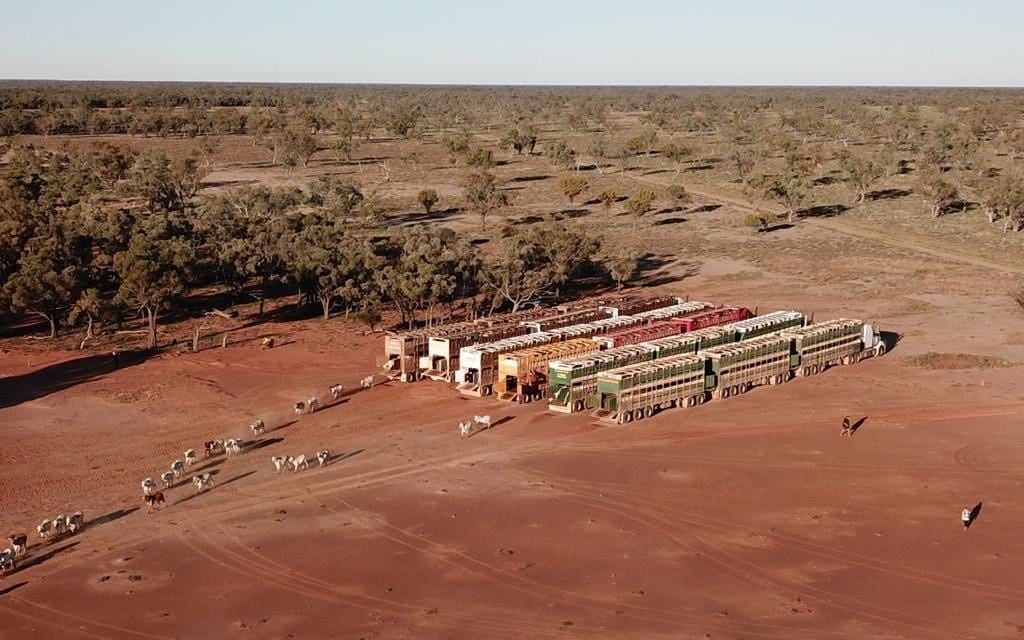
Illustrating the huge logistical challenge involved in placing some of the 38,000 head purchased by Moonie cattleman Mitchell Cameron on agistment, are these six road trains, each carrying six decks, dropping cattle off to a property near Barringun in NSW. Source: Mitchell Cameron
Editor’s note: Mitchell Cameron’s case study published below is part of a feature running today on Beef Central, documenting five of the smartest cattle trades we’ve seen during 2021. Click here to access the full report.
IN ONE of the largest cattle deals in recent years without a property transaction being involved, 38,000 head of cattle have been bought and agisted by one producer on paddocks scattered across Queensland and New South Wales – before being sold into the booming feeder market this year.
Mitchell Cameron, from Moonie in Southern Qld, began a mammoth logistical effort in the middle of last year – purchasing light Brahman and Brahman cross cattle to agist on properties across NSW and Qld. The area was coming back from a major drought and was very lightly stocked.
“In 2019 we sold a farm, so we finished the drought in a pretty good financial position without too much debt,” Mr Cameron said.
“We were also custom feeding a lot of cattle in feedlots during the drought and we did pretty well out that.”
“We were in a position to buy cattle and there was plenty of agistment around – then it all just snowballed from there.”
Mr Cameron’s strategy was to buy each mob of cattle, then find the agistment for them.
The instructions for the driver were to call us in Augathella to see if they should go south or east
“At times we had trucks coming down from Central Queensland and the instructions for the driver were to call us in Augathella to see if they should go south or east because it was so easy to find agistment. The most properties we were using at one time was 57,” he said.
Mr Cameron started sourcing cattle from saleyards across NSW and Qld – then scrambling to find agistment for them. When money ran low, he started buying from the paddock for 10c more than the rate, with terms to pay them off in six months’ time.
“Originally we were after light cattle that we could hold on to for a year, but then we loosened that requirement to just young cattle in general,” he said.
“We were mostly after dry cattle because they were easier to handle and trade. But we did buy a big run of cows and calves at one point.
“We put some Angus bulls over the Brahman heifers, and we still have some of them on agistment.”
The Camerons sold most of the cattle this year through a variety means, with almost half going direct to feedlots, with cattle now averaging 250c/kg more than they were back then.
“Originally, we were looking at $130-$140 per head for a six-month trade but the general margin per animal ended being about three times what we thought,” he said.
“Some of the cattle we joined were worth $800 when we bought them, and now you can sell them for more than $3000 with a calf on them.”
Mr Cameron said the family was mainly breeding these days, with about 10,000 adult cattle still on agistment, 5000 on their own properties and he is expecting to brand about 8500 calves.
Gamble pays off
Mr Cameron’s agent Anthony Triggs from Grant Daniel & Long in Goondiwindi said it was a massive gamble at the time to put the cattle on agistment.
“Everyone was only just coming out of the drought in NSW, they were looking for cash-flow but it was still a bit dry,” Mr Triggs said.
“There was a lot of panic selling at the start of COVID because there was so much demand for meat, but Mitchell decided to hold on to cattle, and that really paid off.
“I think it was a bigger effort than Tom Brinkworth’s drove from Longreach to NSW, at only a third of his age.”

Excellent business model based on this analysis. Taking a bigger picture, or long game approach like Holmes a’Court – it would appear that the previous owner/s of these 38 000 head might need to revisit their overall business strategy, if the replacement of these cattle might cost four to six times the value that they were disposed at? It appears to indicate a lack of planed resilience in their place of origin?
Well done Mitchell, fortune favours the brave.